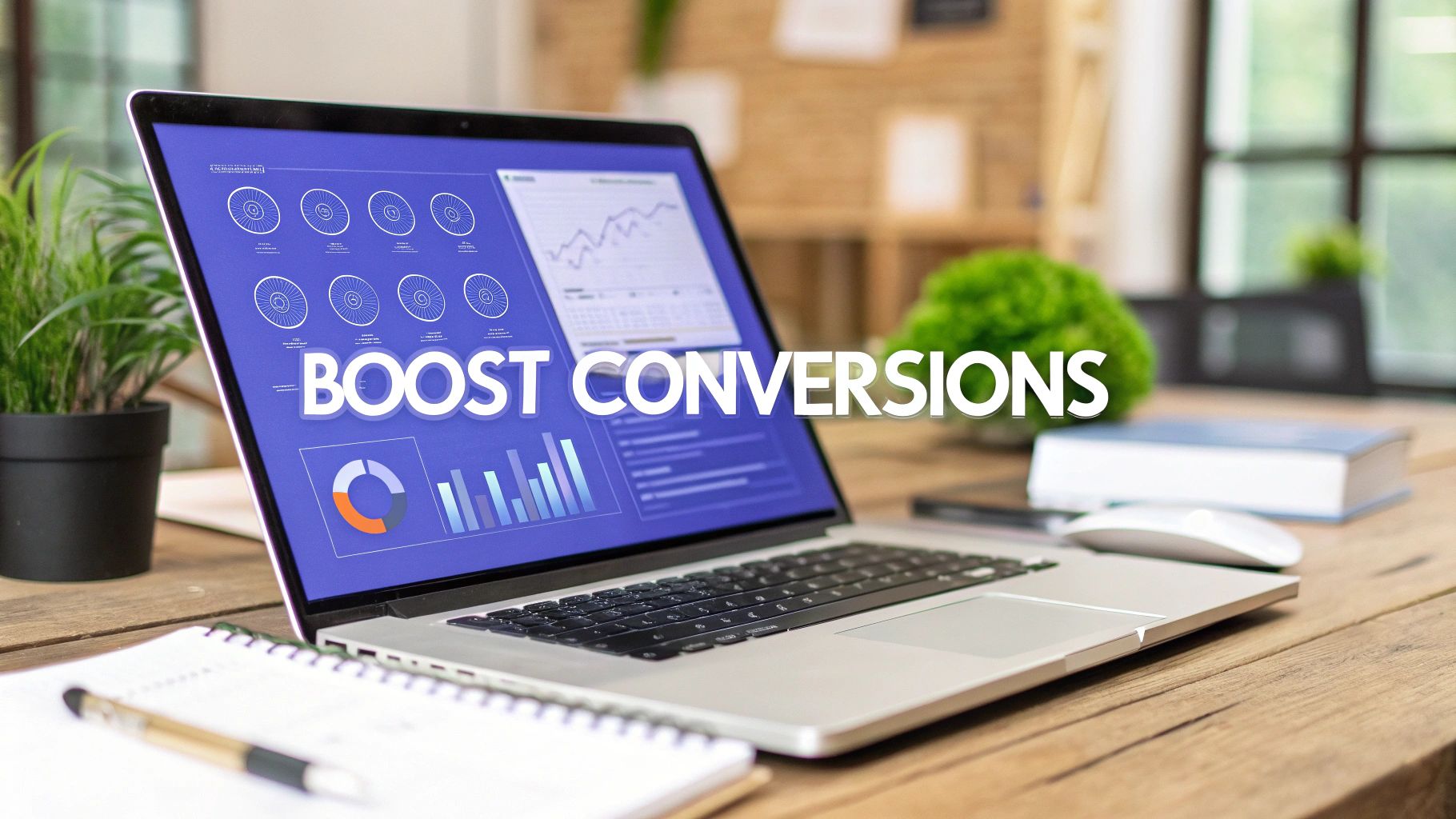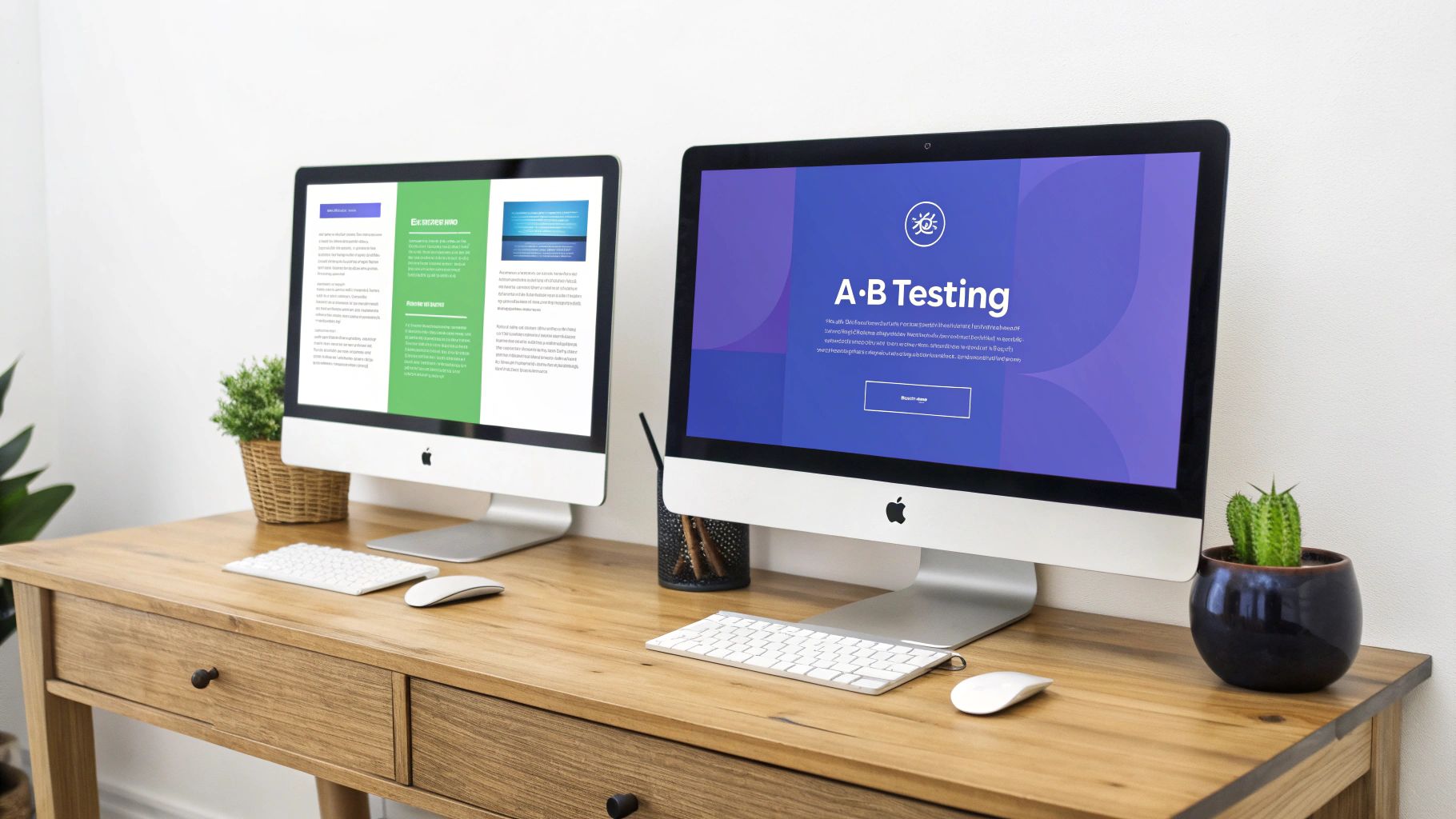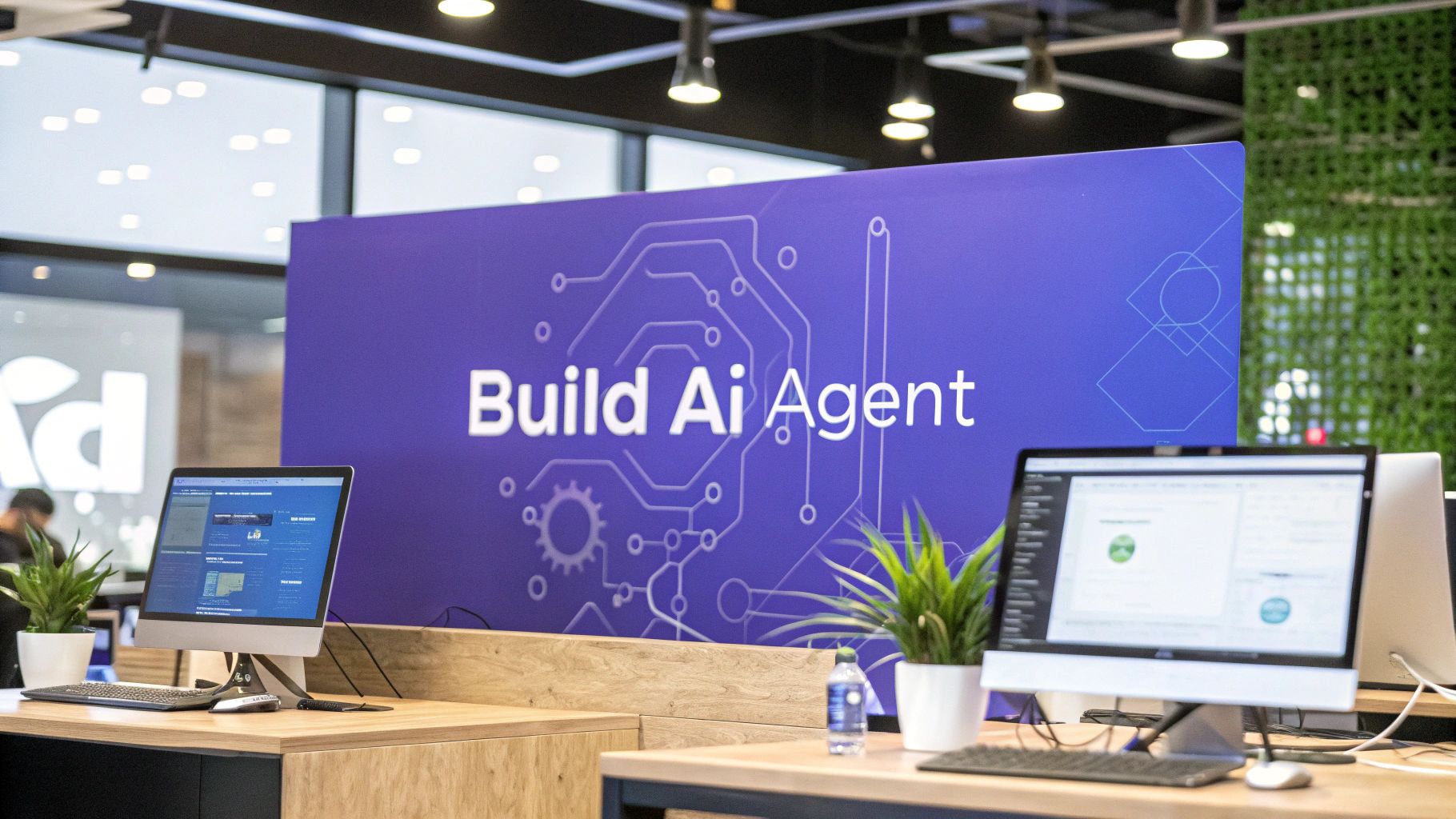9 Proven Ways to Improve Website Conversions in 2025
Unlock higher engagement and sales. Discover 9 powerful, data-driven strategies to improve website conversions and boost your bottom line this year.

In today's crowded digital marketplace, attracting visitors is only half the battle. The real challenge lies in turning that traffic into tangible results, such as sales, sign-ups, and loyal customers. If your website analytics show high traffic but low engagement, you are not alone. Many businesses struggle to bridge the gap between visitor interest and decisive action. The key isn't just more traffic; it's more effective traffic. This is where conversion rate optimization (CRO) becomes essential, transforming your website from a passive brochure into an active sales tool.
This comprehensive guide is designed to shift your focus from simply attracting eyeballs to strategically guiding visitor actions. We will explore nine powerful, data-backed strategies that go beyond surface-level tweaks and provide a clear blueprint to improve website conversions. You will learn how to systematically dismantle the barriers that prevent visitors from taking the next step.
From the psychological power of social proof and trust signals to the technical precision of A/B testing and page speed optimization, each point is a critical component of a high-performance website. We will also cover:
- Optimizing call-to-action (CTA) buttons for maximum impact.
- Implementing a mobile-first design for today's on-the-go users.
- Streamlining the checkout process to reduce cart abandonment.
- Using personalization to create a unique user experience.
- Leveraging urgency and scarcity without alienating customers.
- Capturing leads with effective exit-intent popups.
Prepare to transform your digital storefront into a conversion powerhouse. The following sections offer actionable steps to ensure every visitor has a clear and compelling path to becoming a customer.
1. A/B Testing and Split Testing
The foundation of effective conversion rate optimization is data-driven decision-making, not guesswork. A/B testing, also known as split testing, is a methodical approach that allows you to compare two versions of a single webpage or app screen (Version A and Version B) to see which one performs better. By showing these different versions to segments of your live audience simultaneously, you can collect empirical data on which design, copy, or layout drives more sign-ups, sales, or clicks.

This process eliminates subjective debates among team members and provides concrete evidence about what truly resonates with your users. The impact of this rigorous testing can be monumental. For example, Barack Obama's 2008 campaign famously increased donation conversions by 40% simply by testing different button text and media players. Similarly, Netflix continuously tests thumbnail images, which has led to a 20-30% improvement in member engagement.
How to Implement A/B Testing Effectively
To improve website conversions through testing, a structured approach is essential. Focus on isolating one variable at a time to understand its direct impact.
- Prioritize High-Impact Elements: Start with changes that have the greatest potential to influence user behavior. Test your primary headline, call-to-action (CTA) button copy and color, hero images, or form field layouts first.
- Ensure Statistical Significance: To trust your results, you need sufficient traffic and conversions. Use an A/B test calculator to determine the sample size required before launching your experiment. Running a test for too short a period with low traffic can lead to false conclusions.
- Run Tests for a Full Cycle: Let your experiment run for at least one full business cycle, typically one or two weeks. This helps normalize for daily fluctuations in user behavior, such as differences between weekday and weekend traffic.
- Document Everything: Keep a detailed log of every test you run, including your hypothesis, the variations, the results, and key learnings. Losing tests often provide the most valuable insights into your audience's preferences. This creates a powerful knowledge base that informs future optimization strategies.
By adopting this disciplined methodology, you can systematically refine your user experience and create a high-performing website. For a deeper dive into this topic, explore these expert resources on website conversion optimization.
2. Social Proof and Trust Signals
One of the most powerful psychological drivers you can leverage to improve website conversions is social proof. This principle, popularized by psychologist Robert Cialdini, describes our natural tendency to assume that the actions of others reflect the correct behavior in a given situation. By showcasing that other people trust and value your brand, you significantly reduce friction and anxiety for new visitors, making them more confident in their decision to convert.

This tactic is ubiquitous because it works. Amazon’s customer review system is a foundational element of its multi-trillion-dollar valuation, providing social proof at a massive scale. Similarly, booking platforms like Airbnb and TripAdvisor build their entire ecosystems on the trust generated by peer reviews. Even small signals, like Shopify’s real-time notifications showing "27 people have this in their cart," create urgency and validate a product's popularity, compelling others to act.
How to Implement Social Proof and Trust Signals
To effectively build credibility, you need to strategically integrate various forms of proof across your website, especially near key decision points like checkout pages and sign-up forms.
- Display Authentic Testimonials and Reviews: Go beyond generic praise. Feature detailed testimonials that include the customer's full name, company, and photo. Specific stories about how your product solved a real problem are far more persuasive. Video testimonials can be even more impactful.
- Showcase Trust Badges and Security Seals: Prominently display logos from well-known clients, industry awards, media mentions, and security certifications (like SSL, McAfee, or Norton). These visual cues instantly communicate credibility and assure users their data is safe.
- Leverage Real-Time Data: If applicable, use plugins or custom code to show how many people are currently viewing a product, have recently purchased an item, or have signed up for a service. This creates a sense of a bustling, active community.
- Highlight User Numbers and Case Studies: Quantifiable data, such as "Trusted by over 50,000 businesses" or "1 million downloads," provides powerful, at-a-glance validation. In-depth case studies offer a more detailed narrative of success that resonates with B2B audiences.
By weaving these elements into your user experience, you create an environment of trust that reassures potential customers and directly contributes to a higher conversion rate.
3. Optimizing Call-to-Action (CTA) Buttons
A Call-to-Action (CTA) is the gateway to your conversion goal. It's the button, link, or text that prompts a user to take a specific action, like "Buy Now" or "Sign Up Free". Optimizing these CTAs involves a strategic approach to their design, copy, and placement to make them as compelling and visible as possible. A well-crafted CTA removes friction and clearly guides users down the conversion funnel, directly influencing your site's performance.

The power of a simple change in a CTA cannot be overstated. For instance, Unbounce famously increased conversions by 90% just by changing its button text from the generic "Start your free trial" to the more action-oriented "Get Started". Similarly, HubSpot has demonstrated through extensive testing that their orange CTAs consistently outperform other colors, highlighting the impact of visual contrast. These examples show that minor tweaks can yield major returns.
How to Implement CTA Optimization Effectively
To improve website conversions, your CTAs must be impossible to ignore and easy to understand. This requires a focus on both psychological triggers and visual design principles.
- Use Action-Oriented and Value-Driven Copy: Instead of passive phrases, use strong action verbs that create a sense of urgency or highlight the benefit. "Get My Free Guide" is more persuasive than "Download". Align the text with the user's motivation and what they will receive.
- Focus on Visual Prominence: Your CTA must stand out from the rest of the page. Use a contrasting color that aligns with your brand but pops against the background. Ensure the button is large enough to be easily seen and clicked, especially on mobile devices.
- Strategic Placement is Key: Position CTAs where users naturally pause or look for next steps. Placing them above the fold is a classic best practice, but also consider adding them after key value propositions or at the end of content sections.
- Continuously Test Everything: The perfect CTA is discovered, not guessed. Systematically test variations of your button's color, size, shape, and text. Even a subtle change can have a significant impact on click-through rates and overall conversions, making it a critical area for ongoing optimization.
4. Page Load Speed Optimization
In the digital world, speed is not a luxury; it is a fundamental user expectation. Page load speed optimization involves a set of techniques designed to reduce the time it takes for a webpage to fully load and become interactive for the user. Since modern consumers have little patience for delays, even a one-second lag can lead to increased bounce rates, lower engagement, and a direct, negative impact on your bottom line.

The financial stakes of a slow website are well-documented. Amazon famously calculated that every 100-millisecond delay costs them 1% in sales, a staggering figure for an e-commerce giant. Similarly, Walmart discovered a 2% increase in conversions for every one-second improvement in its page load time. Pinterest drove this point home by reducing perceived wait times by 40%, which resulted in a 15% increase in both search engine traffic and sign-ups. These examples show that speed is a critical component to improve website conversions.
How to Implement Page Load Speed Optimization
To accelerate your website and boost performance, focus on a combination of front-end and back-end improvements. These practical steps can deliver immediate and measurable results.
- Optimize Your Images: Large, uncompressed images are a primary cause of slow pages. Compress images before uploading them and use modern formats like WebP, which offers superior compression compared to traditional JPEG or PNG files. Implement lazy loading so that images below the fold only load as the user scrolls down.
- Leverage Browser Caching and a CDN: Configure browser caching to store static files (like logos, CSS, and JavaScript) on a visitor's device, so they don't have to be re-downloaded on subsequent visits. Use a Content Delivery Network (CDN) to distribute your site's assets across a global network of servers, ensuring faster delivery to users regardless of their geographic location.
- Minify and Combine Code: Reduce the size of your HTML, CSS, and JavaScript files by minifying them, which removes unnecessary characters like spaces and comments without affecting functionality. Combine multiple CSS or JavaScript files into a single file to reduce the number of HTTP requests the browser needs to make.
- Monitor and Test Performance: Regularly use tools like Google's PageSpeed Insights or GTmetrix to analyze your website's performance. These tools provide a detailed report on what is slowing your site down and offer specific recommendations for improvement. Pay close attention to Core Web Vitals, as they are a key ranking factor for Google.
5. Mobile-First Responsive Design
In an era where mobile browsing has surpassed desktop, building a website that merely "works" on a phone is no longer sufficient. Mobile-first responsive design is a strategic approach that flips the traditional design process on its head. Instead of designing for a large desktop screen and then trying to shrink it down, you start with the smallest screen first and progressively enhance the layout and features for larger devices like tablets and desktops. This ensures a seamless, fast, and intuitive experience for the majority of users.
This methodology forces a focus on what is truly essential, eliminating clutter and prioritizing core content and calls-to-action. The result is a more focused user journey that can significantly improve website conversions. For example, when Starbucks prioritized its mobile-first design, it saw a dramatic increase in mobile orders and customer loyalty. Similarly, the Boston Globe’s responsive redesign led to a 79% increase in mobile readership, demonstrating how a superior mobile experience directly impacts engagement.
How to Implement Mobile-First Design Effectively
Adopting a mobile-first philosophy requires a disciplined focus on the constraints and advantages of mobile devices. This approach enhances usability and performance where it matters most.
- Design for Thumbs: Ensure all interactive elements, like buttons and links, are easy to tap. A common guideline is to make tap targets at least 44x44 pixels to avoid frustrating mis-clicks and improve accessibility.
- Prioritize Essential Content: The limited screen real estate of a mobile device forces you to identify and feature only the most critical content and functionality. This ruthless prioritization often leads to a cleaner, more effective user experience across all devices.
- Test on Real Devices: While browser simulators are helpful for quick checks, they can't replicate the nuances of real-world use. Test your design on various actual smartphones and tablets to account for different screen sizes, operating systems, and performance capabilities.
- Optimize Forms for Mobile: Make data entry effortless. Use appropriate HTML5 input types to trigger the correct mobile keyboards (e.g.,
type="email"for email fields,type="tel"for phone numbers). Break long forms into smaller, manageable steps to reduce user friction.
6. Streamlined Checkout Process
The checkout page is the final and most critical step in the customer journey; it's where a prospect becomes a paying customer. A streamlined checkout process is designed to reduce friction and eliminate any obstacles that might cause a user to abandon their cart. By simplifying this final stage, you can dramatically decrease cart abandonment rates, which often hover around 70% across e-commerce industries. This optimization focuses on speed, clarity, and trust, ensuring the path to purchase is as smooth as possible.
The impact of a frictionless checkout is undeniable. Amazon's patented one-click purchasing set a new standard for online shopping convenience, fundamentally changing user expectations. Similarly, Shopify reports that merchants using their express checkout options, like Shop Pay, see conversion rates up to 35% higher than those with a traditional guest checkout. These examples prove that minimizing steps and building trust directly translates to more completed sales.
How to Implement a Streamlined Checkout
To improve website conversions, your checkout must be intuitive and efficient. Every unnecessary field or confusing step increases the risk of abandonment.
- Offer a Guest Checkout Option: Forcing users to create an account before they can buy is a major conversion killer. Always provide a prominent guest checkout option to avoid this unnecessary barrier.
- Display All Costs Upfront: Surprise fees are the number one reason for cart abandonment. Be transparent about all costs, including shipping, taxes, and any other fees, directly on the cart or first checkout page.
- Provide Multiple Payment Options: Cater to user preferences by offering various payment methods. In addition to credit cards, include digital wallets like PayPal, Apple Pay, and Google Pay, which simplify the process significantly.
- Use Progress Indicators: If your checkout has multiple steps, use a visual progress bar (e.g., Step 1: Shipping > Step 2: Payment > Step 3: Review). This manages user expectations and reduces the feeling of being overwhelmed.
- Reinforce Security and Trust: Prominently display security badges (SSL certificates, McAfee, Norton) and trust seals to reassure users that their financial information is safe. This simple visual cue can significantly boost confidence.
By focusing on these key elements, you can transform your checkout from a potential obstacle into a powerful conversion asset. For more advanced strategies on checkout optimization, explore these resources on the streamlined checkout process.
7. Personalization and Dynamic Content
In an online world saturated with generic messages, personalization cuts through the noise to deliver experiences that feel uniquely tailored to the individual user. This strategy involves using visitor data like behavior, demographics, and location to serve dynamic content, offers, and recommendations. Instead of a one-size-fits-all approach, your website adapts in real-time, making each interaction more relevant, engaging, and persuasive.
This level of customization is a powerful driver to improve website conversions. For example, Amazon’s legendary recommendation engine is responsible for an estimated 35% of its revenue. Likewise, Netflix has stated that its personalization algorithms, which influence everything from suggested shows to thumbnail images, save the company over $1 billion per year by reducing member churn and increasing viewing time. These giants prove that when you show users what they want to see, they are far more likely to convert.
How to Implement Personalization Effectively
Successfully integrating dynamic content requires a thoughtful, data-driven strategy. The goal is to make the user's journey smoother and more relevant, not intrusive.
- Start with Simple Segmentation: You don't need complex algorithms to begin. Start by personalizing content based on easily accessible data. Show different hero banners to new versus returning visitors, or display location-specific offers based on the user's IP address.
- Leverage Behavioral Data: Track on-site actions like pages viewed, products added to the cart, or past purchases. Use this information to create personalized product recommendations, tailor email marketing campaigns, and display relevant articles or resources.
- Customize Calls-to-Action (CTAs): A powerful way to improve website conversions is by making your CTAs dynamic. For instance, a first-time visitor might see a "Sign Up for 10% Off" button, while a returning customer sees a "View Your Loyalty Rewards" button.
- Maintain Transparency and Trust: Personalization relies on user data, so it is crucial to be transparent about what you collect and how you use it. Provide clear privacy policies and give users control over their data to build long-term trust, which is essential for sustained conversions.
8. Urgency and Scarcity Tactics
Human psychology is hardwired to avoid loss, a principle that can be ethically leveraged to drive immediate action. Urgency and scarcity tactics tap into this by creating a sense that an opportunity is limited by time or availability. These techniques combat user procrastination by introducing a compelling reason to act now rather than later, which is a powerful way to improve website conversions. When users perceive that a product, service, or special offer might disappear, they are more motivated to complete the purchase.
This psychological trigger is famously used by travel and e-commerce giants. Booking.com, for example, displays messages like "Only 2 rooms left on our site!" to highlight limited availability, encouraging immediate bookings. Similarly, Amazon's "Lightning Deals" feature a prominent countdown timer, creating a powerful sense of urgency that has become a cornerstone of their sales events. These strategies work because they shift the user's focus from "Should I buy this?" to "Should I buy this now before it's gone?".
How to Implement Urgency and Scarcity Effectively
To successfully use these tactics without alienating customers, your approach must be genuine and value-driven. The goal is to inform, not to pressure dishonestly.
- Be Authentic and Specific: Your claims must be truthful. If you say only three items are left in stock, it must be true. Use specific numbers ("Only 3 left") instead of vague phrases ("Selling fast!"), as specificity builds more trust and is more persuasive.
- Use Countdown Timers for Offers: Implement timers for special promotions, flash sales, or next-day shipping cutoffs. Visibly showing time ticking away creates a tangible deadline that prompts users to make a decision.
- Show Real-Time Stock Levels: For physical products, displaying low stock levels (e.g., "Only 5 left in stock") leverages scarcity. This is particularly effective for popular items, signaling social proof and limited availability simultaneously.
- Combine Urgency with Clear Value: Scarcity alone is not enough. Ensure your offer is compelling. The urgency should be tied to a clear benefit for the customer, such as a discount, a bonus item, or access to an exclusive product. This ensures the motivation is rooted in value, not just fear of missing out.
By carefully integrating these elements, you can create a powerful incentive that encourages decisive action and boosts your conversion rates. For a deeper understanding of the psychological principles at play, explore Robert Cialdini's work on scarcity.
9. Exit-Intent Popups and Lead Magnets
Not every visitor is ready to convert on their first visit, but that doesn't mean their journey has to end when they move their cursor to close the tab. Exit-intent technology intelligently detects when a user is about to leave your website and triggers a targeted popup or overlay. This provides one final, valuable opportunity to capture their attention, re-engage them, or secure their contact information for future nurturing.
This strategy is highly effective because it intercepts users at a critical moment without disrupting their initial browsing experience. Instead of losing a visitor forever, you can present a compelling offer, like a discount or a valuable piece of content, that persuades them to stay or connect. For instance, Sumo famously used exit-intent popups to grow their email list by 400%, and industry data from OptinMonster shows these campaigns can convert an average of 3-9% of abandoning visitors, a significant boost that can improve website conversions dramatically.
How to Implement Exit-Intent Popups Effectively
To make this tactic work, your offer must provide genuine value and be presented in a user-friendly way. The goal is to be helpful, not intrusive.
- Offer a Powerful Lead Magnet: Your popup is an interruption, so make it worthwhile. Provide something genuinely valuable in exchange for an email address, such as a comprehensive ebook, an exclusive checklist, a free tool, or a first-time purchase discount. Neil Patel successfully uses this by offering free marketing tools to abandoning visitors.
- Keep the Design Clean and Focused: Don't overwhelm the user. Use a simple, on-brand design with a clear headline, concise copy explaining the benefit, and a single, prominent call-to-action (CTA). The user should understand the offer and how to claim it in seconds.
- Optimize for Mobile: A clunky or hard-to-close popup on a mobile device is a guaranteed way to frustrate users. Ensure your exit-intent popups are responsive, easy to navigate on small screens, and have a clear, easily tappable close button.
- Test and Refine Your Triggers: Experiment with the sensitivity of the exit-intent trigger. Should it appear instantly as the cursor leaves the page, or after a one-second delay? Test different offers, headlines, and designs to see what resonates most with your audience and prevents potential leads from slipping away.
By strategically capturing abandoning visitors, you can turn a potential loss into a long-term gain. For more advanced lead-capturing strategies, consider exploring how a chatbot can be used for lead generation.
9 Strategies to Improve Website Conversions Comparison
From Insight to Action: Your Next Steps in Conversion Mastery
We've journeyed through a comprehensive blueprint designed to systematically improve website conversions. You now have a powerful arsenal of nine distinct, yet interconnected, strategies at your disposal. This is not about finding a single, magical fix. Instead, true conversion mastery comes from embracing a mindset of continuous, incremental improvement.
The path forward involves weaving these individual tactics into a cohesive, data-informed strategy. From the foundational precision of A/B testing and the psychological power of social proof to the critical, functional necessity of page speed optimization and mobile-first design, each element plays a vital role in your user's journey. Your website is no longer a static digital storefront; it is a dynamic, evolving ecosystem that must adapt to user behavior and expectations.
Synthesizing the Strategies: From Theory to Reality
Think of these strategies not as a checklist to be completed once, but as a cycle of optimization. Your A/B tests on CTA buttons will generate data that informs your personalization efforts. The insights gained from your streamlined checkout process might reveal friction points that an exit-intent popup can help solve. The goal is to create a virtuous cycle where each improvement builds upon the last, creating a compounding effect on your conversion rates.
The key is to move from understanding these concepts to implementing them effectively. The most successful teams, from sales and operations to developers and designers, are those who institutionalize this process of testing, learning, and refining. They don't just ask "what can we change?" but rather "what can we test to learn more about our users?" This shift in perspective is what separates stagnant websites from high-performing conversion engines.
Your Actionable Roadmap to Higher Conversions
Feeling overwhelmed by the possibilities is natural. The secret to making progress is to start small and build momentum. Don't try to implement all nine strategies at once. Instead, adopt a phased approach to systematically improve website conversions over time.
Here is a practical, step-by-step plan to get you started:
- Establish Your Baseline: Before you change anything, you need a clear picture of your current performance. Use analytics tools to identify your primary conversion funnels and establish baseline metrics for each step. Where are users dropping off? Which pages have the highest bounce rates? This data is your treasure map.
- Target the Low-Hanging Fruit: Begin with the changes that offer the highest potential impact for the lowest effort. This often includes CTA optimization (changing colors, copy, or placement) and page load speed improvements. These foundational fixes can deliver quick wins and build confidence within your team.
- Build Trust and Reduce Friction: Next, focus on making your visitors feel secure and confident. Implement social proof like testimonials and partner logos. Conduct a ruthless audit of your forms and checkout process, eliminating every unnecessary field and step to make converting as effortless as possible.
- Layer in Advanced Tactics: Once the fundamentals are solid, you can introduce more sophisticated strategies. Begin experimenting with personalization to deliver dynamic content based on user segments. Deploy well-timed exit-intent popups with valuable lead magnets to capture abandoning visitors. Use subtle urgency and scarcity cues to encourage immediate action.
Remember, the journey to improve website conversions is a marathon, not a sprint. Celebrate small victories, share your learnings across departments, and remain relentlessly focused on the user experience. By committing to this iterative process, you will transform your website from a passive information hub into your most powerful tool for business growth. Your efforts will not only boost metrics but also foster a deeper, more valuable relationship with your customers.
Ready to supercharge your user engagement and capture more leads automatically? Chatiant provides an AI-powered chatbot solution that guides visitors through your funnel, answers questions instantly, and helps you improve website conversions 24/7. Discover how you can turn more conversations into conversions by visiting Chatiant today.


